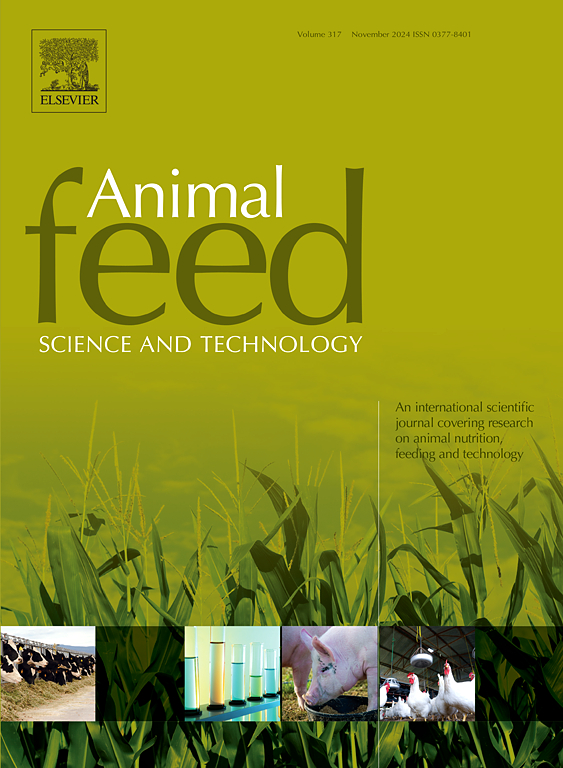不同水分条件下脱皮和烘烤对蚕豆化学成分和原位瘤胃蛋白质降解的影响
IF 2.5
2区 农林科学
Q1 AGRICULTURE, DAIRY & ANIMAL SCIENCE
引用次数: 0
摘要
采用原位法,研究了不同干物质(DM)含量下脱皮和湿烤对蚕豆饲料价值的影响。对水分含量约为12 %的蚕豆进行润湿,使其水分含量分别为12 %、18 %和25 %。首先,在4 × 2因子设计中,研究了烤湿和脱壳的影响,因子1包括:(1)在12 %的水分下未烤,(2)在12 %的水分下烤,(3)在18 %的水分下烤,(4)在25 %的水分下烤。因素2包括:去壳或去壳。其次,考察了焙烧(含水率为12 %)和脱壳顺序的影响。第三,对壳的营养价值进行了评价。湿烤和脱皮均能提高蚕豆粗蛋白质含量。湿烤导致干物质、粗蛋白质和不含粗蛋白质的干物质的瘤胃降解率降低,肠道和全肠消失率提高。蚕豆去皮导致干物质、粗蛋白质和不含粗蛋白质的aNDFom含量降低,干物质、粗蛋白质和不含粗蛋白质的瘤胃降解率提高,干物质、粗蛋白质和无粗蛋白质的肠道消失率提高。脱皮后烘烤提高了干物质含量,但不影响粗蛋白质的瘤胃降解率。烘烤前将蚕豆水分含量从12%提高到18%和25% %,可降低干物质、粗蛋白质和无粗蛋白质的瘤胃有效降解率,但提高了干物质、粗蛋白质和粗蛋白质的全肠和肠道消失率。综上所述,脱皮可以通过降低和form含量、提高粗蛋白质和淀粉含量来提高蚕豆的营养价值。在潮湿的条件下烤蚕豆。直接从收获中提取,最有效地保护粗蛋白质和不含粗蛋白质的DM不被瘤胃降解,增加了粗蛋白质和不含粗蛋白质的DM在肠道和全肠道的消失。蚕豆皮的营养价值较低,对湿烤的影响有限。本文章由计算机程序翻译,如有差异,请以英文原文为准。
Effect of dehulling and toasting at different moisture contents of fava beans (Vicia faba) on chemical composition and in-situ ruminal protein degradation
The objective of this study was to investigate the effect of dehulling and moist toasting at different dry matter (DM) contents on the feed value of fava beans using the in situ methodology. Fava beans with about 12 % of moisture content were moistened to achieve moisture contents of 12 %, 18 %, and 25 %. Firstly, the effect of toast-moist and dehulling was investigated in a 4 × 2 factorial design with factor 1 including: (1) untoasted at 12 % moisture, (2) toasted at 12 % moisture, (3) toasted at 18 % moisture, and (4) toasted at 25 % moisture. Factor 2 including: hulled or dehulled. Secondly, the effect of the sequence of toasting (at 12 % moisture) and dehulling was examined. Thirdly, the nutritive value of hulls was assessed. Moist toasting and dehulling both resulted in a higher CP content of fava beans. Moist toasting led to a lower ruminal degradability and higher intestinal and total-tract disappearance of DM, CP, and CP-free DM. Dehulling of fava beans resulted in a lower aNDFom content, higher ruminal degradability of DM, CP, and CP-free DM and higher intestinal disappearance of DM, CP, and CP-free DM. Toasting after dehulling resulted in a higher DM content but did not affect ruminal degradability of CP. Increasing the moisture content in the fava beans before toasting from 12 to 18 and 25 % moisture resulted in a lower effective ruminal degradability of DM, CP, and CP-free DM, but higher total-tract and intestinal disappearance of DM, CP, and CP-free DM. It was concluded that dehulling was effective to improve fava beans nutritive value by reducing aNDFom content and increasing the CP and starch content. Toasting fava beans in moist condition, eg. directly from harvest, give the most effective protection of CP and CP-free DM from ruminal degradation and increased intestinal and total-tract disappearance of CP and CP-free DM. Fava bean hulls had low nutritional value and was limited affected by moist toasting.
求助全文
通过发布文献求助,成功后即可免费获取论文全文。
去求助
来源期刊

Animal Feed Science and Technology
农林科学-奶制品与动物科学
CiteScore
6.00
自引率
6.20%
发文量
266
审稿时长
3 months
期刊介绍:
Animal Feed Science and Technology is a unique journal publishing scientific papers of international interest focusing on animal feeds and their feeding.
Papers describing research on feed for ruminants and non-ruminants, including poultry, horses, companion animals and aquatic animals, are welcome.
The journal covers the following areas:
Nutritive value of feeds (e.g., assessment, improvement)
Methods of conserving and processing feeds that affect their nutritional value
Agronomic and climatic factors influencing the nutritive value of feeds
Utilization of feeds and the improvement of such
Metabolic, production, reproduction and health responses, as well as potential environmental impacts, of diet inputs and feed technologies (e.g., feeds, feed additives, feed components, mycotoxins)
Mathematical models relating directly to animal-feed interactions
Analytical and experimental methods for feed evaluation
Environmental impacts of feed technologies in animal production.
 求助内容:
求助内容: 应助结果提醒方式:
应助结果提醒方式:


